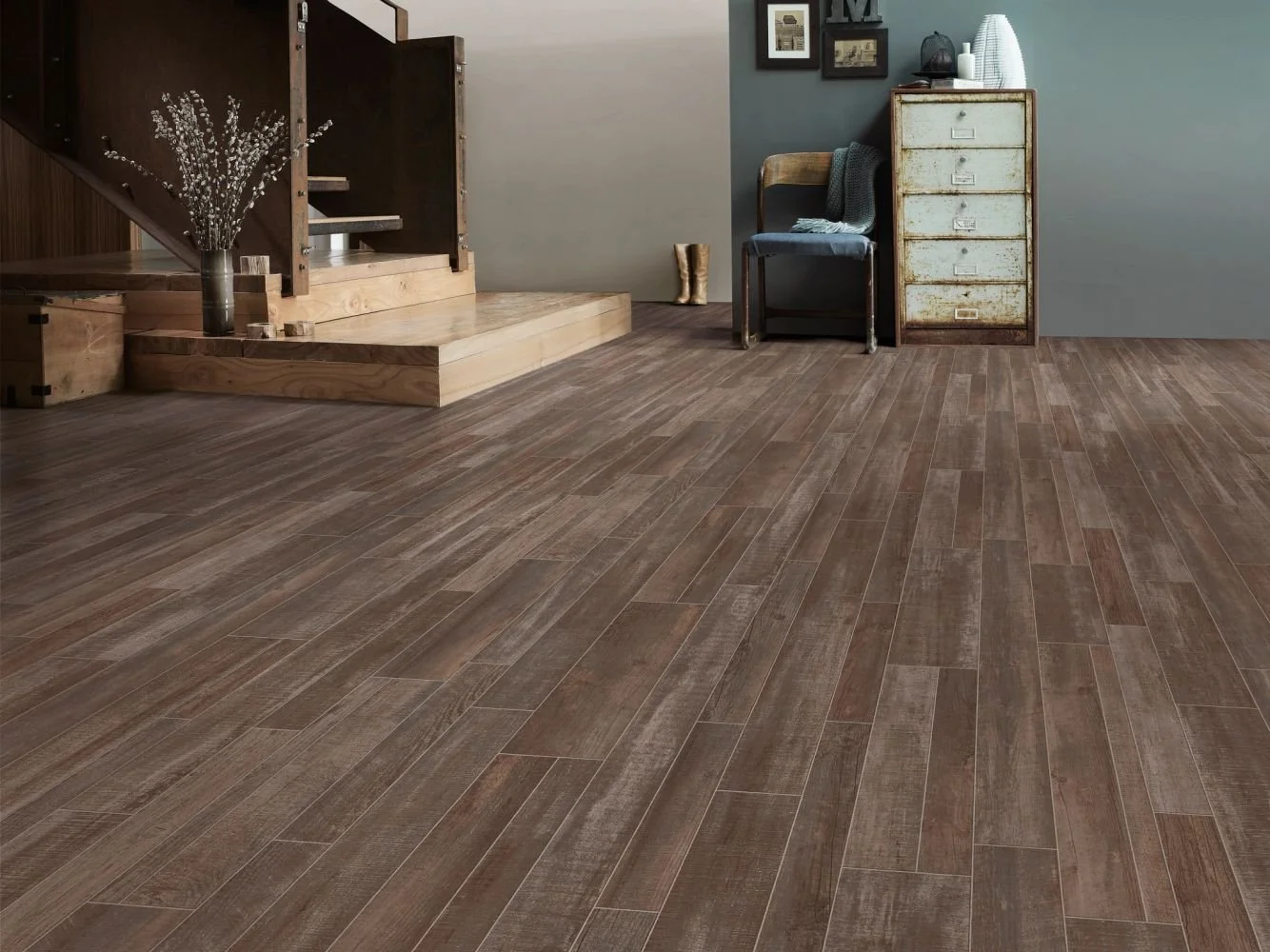
A Cohesive Online Showroom for Premium Flooring Brands
TL;DR
Shaw Floors had tried to modernize the web presence for multiple brands under its roof. But between internal factors and an agency that didn’t quite meet their needs, the results were disappointing. We were called in to come up with something better.
Background
Shaw Floors is one of America’s largest providers of premium flooring materials. Founded in 1967, it has multiple brands under one roof and an extensive catalog of hardwood, vinyl, and carpet products.
In recent years, though, Shaw has seen its web presence lag its product innovation. Their site was fundamentally sound but growing dated. The company’s sales and marketing teams took notice and enlisted an outside agency to help them modernize their branding and UX design as part of a replatforming effort. They came away unsatisfied with the results. The updated site had significant issues with navigation, content balance/hierarchy/ flow, responsive scaling, and administration.
My team and others from Macquarium partnered with Shaw to take another swing at it. We were tasked with understanding Shaw’s product lines, marketing strategies, and sales & IT operations, and with redesigning three of their flagship brand sites - Shaw Floors, COREtec, and Anderson Tuftex. A mid-way curveball added a fourth.
The Challenge
Unfinished Branding
Each brand’s marketing & design standards were in the midst of a major overhaul by Shaw’s marketing team, even as the project was underway.
Fragmented Ownership
Each brand had its own SMEs. As a parent company, Shaw overlapped many of these. Owners and their needs were often unclear until late in the game.
Scope Creep
We started with an aggressive but realistic timeline. But as the challenges appeared, clearly we’d need to bob & weave to help the client through while staying on track.
Design Hangover
Shaw’s recent bad experience left a fair amount of tech & design debt to contend with. Thankfully, they’re a great team and welcomed us with open arms.
Our Approach
Discovery & Benchmarking
We started with a combination of stakeholder interviews, heuristic audits, and competitive & aspirational assessments. In particular, our competitive & aspirational assessments were designed to benchmark Shaw’s legacy and newly-updated sites against both direct competitors and, for creative/functional inspiration, leading indirect competitor brands. These activities teased out what would be needed to elevate both brand standards and website functionality.
Shift to Phased Rollout
One of the side effects of our discovery work was seeing just how much homework both we and Shaw would have to do to fine-tune each of the three brands’ sites for success. Our project plan and budget didn’t allow for everything. Rather than a “big bang” release for all three sites, we shifted to focusing first on COREtec (together with a new, smaller site for builders of multi-family homes), while Shaw Floors and Anderson Tuftex would follow.
Integrating with the Client Team
From here on out, we enjoyed a unique twist to the project. Shaw had a fairly junior UX designer on staff who would be joining our team. While he didn’t have the experience to act as a true “sherpa,” he was motivated, talented, and disciplined enough to provide valuable design input and help with co-creation while also facilitating discussions with stakeholders that would otherwise be hard to have. This was all in addition to us working closely with multiple key stakeholder teams to provide multiple perspectives on the new sites.
Information Architecture & Content Strategy Workshops
One of the biggest weak points of Shaw’s brand sites was how they were organized. Navigation menus played into this, but so did page-level structure, component usage, and content hierarchy. I tasked the UX designers with building out a set of notional site map diagrams in Figjam. We went line-by-line to compare their ideas and identify a hybrid solution that combined the best aspects of each. This draft would be presented to the stakeholders via an extended working session.
Unsurprisingly, while we gained a lot of solid feedback, it was again clear that the client wasn’t fully ready. Large portions of content strategy had not been settled by the Shaw team. I set aside time to triage the open questions and assign owners and deadlines to each; essentially acting as a project manager for the client. This approach was repeated for every Shaw brand.
Project Plan Pivot
We could see that we needed to do more work to help with Shaw’s decision-making. I took a step back with the senior designer and project manager to reassess activities, deliverables, effort, time, and cost. Luckily, we could still go live close to our original target date - if we got creative.
We switched from delivering a single, full set of wireframes to a series of four batches. This let us deliver some pages early based on priority and client readiness. Those with more homework would go into later batches to “bake” more. Each approved batch would go into visual design while the next batch was wireframed in parallel.
Note that this is a riskier way of doing things. There are more moving parts, more concurrency risks, and delays in any one piece can cascade quickly. But we had a firm edict to stick as close as possible to the original timeline, and Shaw was willing to hear and plan for the potential downsides.
Establishing Creative Direction
We also needed to establish creative standards for each site. Not an easy task as Shaw’s marketing team hadn’t settled on a final style guide for any of the brands (concurrency risk). This could lead to extensive rework.. And given how subjective design can be in the eyes of clients, every new opinion or moment of uncertainty can introduce delays (subjectivity risk).
To help with concurrency risk, we consulted intensively with Shaw’s marketing team on their draft style work. To help with subjectivity risk, we staged out our creative reviews to allow a high frequency of marketing feedback on our in-progress moodboards before going too deep into leadership presentations.
Then we carefully presented each element to the broader Shaw leadership team. As always, “why” was even more important than “what.” By being prepared with thorough reasoning and common talking points between our team and marketing, it only took a few rounds of feedback to establish the detailed direction that had been missing from the style guides and would be needed for comps.
Component-Based Wireframing
Shaw uses Kentico as both a content management system (CMS) and digital asset management (DAM) platform. This allows each page to be highly modular; essentially a collection of digital Lego blocks. Using the existing site, new site map, and content & sales strategy as a guide, we created a component manifest. This served as both an overall checklist for our deliverables and a sort of menu of component options for each page. Components were designed according to the batching plan and reused where appropriate (giving us more speed later on). We then assembled them into responsive page templates. After the usual rounds of client review and revision, it was off to visual design.
Visual Design Excellence
The batch-based process continued with the creation of high-fidelity comps. As with wireframes, these were blown out to reflect responsive scaling, but went deeper into component specifications and brand standards. Comps were bespoke to each site but maintained a reassuring feel of commonality, reinforced by structural decisions. In this phase, subjectivity tends to come to the fore as clients see something more like the finished product. Half the battle was in our communication; every presentation was extensively briefed and rehearsed. The rest was mostly already solved by this point. So, comps were blessed quite quickly. Rejoice!
Clean Handoff
For this project, Macquarium would work in tandem with Shaw for development, QA, and post-release maintenance & analytics. To make sure they had everything needed, we prepared an additional breakdown of all of our design deliverables that emphasized technical details, flow paths, responsive scaling, and more. It wouldn’t do to simply toss it over the wall and hope for the best, so we further assisted by providing both an initial briefing and ongoing office hours throughout the dev & QA phases, as well as support for occasional UI tweaks when the need arose.
My Role
Led the Macquarium design team in its engagement with Shaw Floors
Partnered with sales, marketing, IT, and Shaw’s UX designer to understand website needs, capabilities, and limitations
Guided the definition of a new information architecture and product presentation strategy
Led and oversaw the creation of conceptual and detail designs and supporting assets
Collaborated with the client and project managers to manage the project plan in a very fluid environment
Led collaboration & cross-training between UX designers at both Macquarium and Shaw Floors
Coordinated deeper discovery and problem-solving on the client’s content strategy
The Solution
Reimagined navigation, layouts, and creative
Mobile-first design to fit real-world shopping behavior
Comprehensive product catalog upgrades - both visual and functional
Renewed focus on reasons to believe
Richer, more intuitive product detail pages
The Results
Content & Design Meet User Intent
Rebalanced layouts and intuitive filters align content and design to user needs. Care guides, benefits, specs, and more are exactly where customers need them.
A Seamless Cross-Brand Experience
Unified IA across Shaw Floors, COREtec and Anderson Tuftex delivers a cohesive, cross-brand journey—users transition effortlessly between sites and locate products & information far more easily.
A Brand Site & eCommerce Rescue
Despite our need to duck & weave around unexpected complications, the new sites were elevated from faltering in the real world to top-tier, flexible, scalable environments.

